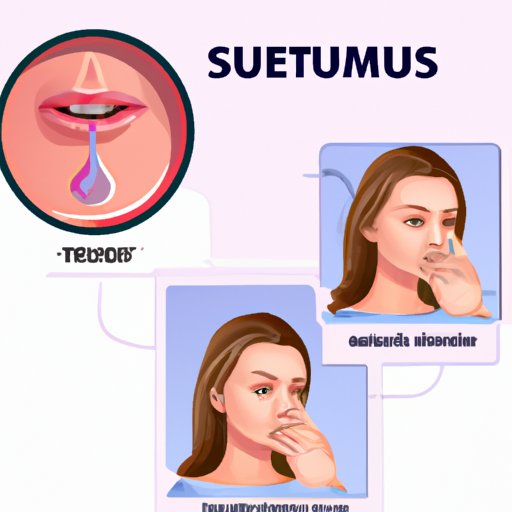
I. Introduction
Deviated septum is a common condition that affects many people worldwide. It is a condition where the nasal septum, the area that separates the two nostrils, is displaced or crooked. This condition can cause a variety of symptoms such as breathing difficulties, congestion, and nosebleeds. In this article, we will explore the causes, symptoms, diagnosis, treatment, prevention, and misconceptions surrounding the topic of deviated septum.
II. Medical Causes of Deviated Septum
Deviated septum can be caused by several medical factors which include:
Genetic factors: Some people are born with a crooked nasal septum due to genetic factors.
Developmental abnormalities: In some cases, the nasal septum may develop irregularly during fetal development or childhood.
Injuries that damage the nasal septum: Accidents that involve direct trauma to the nose, such as sports injuries or car accidents, can cause the nasal septum to become crooked or displaced.
III. Symptoms of Deviated Septum
The symptoms of deviated septum can vary depending on the degree of displacement. Some of the common symptoms are:
Breathing difficulties: Difficulty breathing through one or both nostrils.
Snoring and sleep apnea: Disrupted breathing during sleep, characterized by snoring, gasping, or pauses in breathing.
Congestion and sinus infections: Difficulty breathing due to nasal congestion, and recurrent sinus infections.
Nosebleeds: Recurrent nosebleeds due to the build-up of mucus and dryness in the nasal cavity.
IV. Diagnosis and Treatment Options
Diagnosis of a deviated septum typically involves a physical examination and medical history. Imaging tests such as X-rays, CT scans, or MRI may be recommended. Treatment options range from conservative measures such as medication and lifestyle changes to more invasive procedures like surgery.
Physical exams and medical history: Your doctor will check your nasal passages for signs of obstruction and inquire about your medical history, including symptoms and family history of deviated septum.
Imaging tests: Your doctor may recommend imaging tests to provide a more detailed view of your nasal passages, allowing for a more accurate diagnosis.
Medications: Medications such as nasal decongestants, antihistamines, and nasal corticosteroids can help alleviate symptoms of deviated septum, such as congestion and inflammation.
Surgical procedures: If conservative measures fail to alleviate symptoms, surgical procedures such as septoplasty may be recommended. Septoplasty is a surgical procedure that involves the straightening of the nasal septum to alleviate breathing difficulties.
V. Prevention Tips for Avoiding a Deviated Septum
Prevention of deviated septum involves taking measures to protect your nose from injuries, maintaining a healthy nasal passage, and avoiding smoking and air pollution.
Protecting your nose from injuries: Wearing protective gear during sports, driving carefully, and avoiding physical altercations can help prevent trauma to the nasal septum, which can cause deviations.
Maintaining healthy nasal passages: Practicing good hygiene, such as regularly blowing your nose and using a saline nasal spray can help keep nasal passages clean and healthy.
Avoiding smoking and air pollution: Reducing exposure to cigarette smoke and air pollution can prevent inflammation and irritation of the nasal passages, which can lead to deviated septum.
VI. Living with a Deviated Septum
Living with a deviated septum may require lifestyle changes such as avoiding allergens, using a humidifier, and sleeping on your side. Psychological support, such as counseling, can also help you cope with the psychological impact of living with a deviated septum.
Lifestyle changes to alleviate symptoms: Sleeping on your side or using a humidifier can help improve breathing while reducing dryness in the nasal passages.
Coping mechanisms and psychological support: Seeking psychological support can help alleviate the negative impact that deviated septum can have on your mental health, such as anxiety and depression.
Long-term treatment plans: Regular checkups with your doctor can ensure that your symptoms are continually monitored, and appropriate treatment is prescribed to prevent further complications.
VII. Debunking Common Misconceptions about Deviated Septums
There are several misconceptions surrounding deviated septums, including the belief that it is a result of poor hygiene, and that surgery is the only treatment option. It is essential to address these misconceptions to ensure that people obtain accurate information about the condition.
Addressing common questions and concerns: Demystifying inaccurate information surrounding deviated septum can provide clarity to those seeking information about the condition.
Clarifying misunderstandings: By providing accurate information about the condition, misconceptions and misunderstandings surrounding deviated septum can be cleared up.
VIII. Conclusion
In conclusion, deviated septum is a common condition that can cause a variety of symptoms that can negatively affect an individual’s quality of life. It is crucial to seek medical attention and to obtain accurate information about the condition to receive the appropriate diagnosis and treatment. Lifestyle changes may help alleviate symptoms, and psychological support may assist in coping with the mental impact of living with the condition.
Seek Medical Attention: Don’t suffer in silence. Seek help if you suspect you have a deviated septum.
Final thoughts and advice: With proper diagnosis and appropriate medical intervention, living with deviated septum can be manageable, allowing you to live a fulfilling life.




